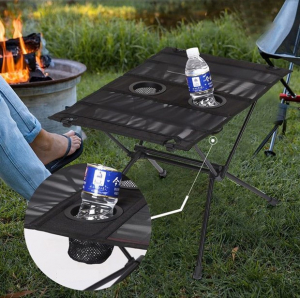News Center+ 查看更多
The Evolution of Camping Table Materials: Catering to the Modern Hiker and Backpacker+ 查看更多
Aluminum Alloys: The Backbone of Portable Tables
Aluminum alloys have emerged as the frontrunners in the construction of camping tables. With their remarkable strength-to-weight ratio, they offer sturdy support while remaining significantly lighter than traditional materials. Corrosion resistance is another feather in their cap, allowing them to withstand diverse outdoor conditions. These characteristics make aluminum alloy tables a popular choice, providing a stable surface that doesn't weigh down the adventurer. Their role in enhancing portability while maintaining structural integrity is a testament to the ingenuity of modern material science.
Carbon Fiber: The Pinnacle of Lightweight Strength
When it comes to cutting-edge materials, carbon fiber stands in a league of its own. This robust yet lightweight material is commonly utilized in the construction of high-end camping tables. Boasting a strength that surpasses steel, it remains astoundingly lighter, making it a favored material among those seeking the ultimate in lightweight gear. Its resistance to moisture and wear and tear adds to its allure, offering durability in a variety of outdoor scenarios. The use of carbon fiber in camping tables exemplifies the relentless pursuit of innovation in outdoor equipment design.
Folding Designs: The Art of Compactness
The incorporation of folding designs has been a game-changer in the world of camping tables. This feature allows the table to collapse into a compact form, facilitating effortless transport and storage. By reducing both volume and weight, these designs cater to the hiker's need for convenience without sacrificing surface area. It is this blend of practicality and efficiency that has propelled the folding camping table to become a staple in the backpacker's inventory.
Detachable Components: Customization Meets Convenience
Another noteworthy innovation is the introduction of detachable components in camping tables. This modular approach allows users to dismantle legs and other parts, further minimizing the overall size and weight. The flexibility to assemble and disassemble on the go makes these tables particularly attractive to travelers who value adaptability alongside ease of transport. It is through such thoughtful design considerations that camping tables can offer an unparalleled combination of portability, stability, and durability.
In conclusion, the application of lightweight materials and thoughtful design in camping tables has revolutionally catered to the needs of modern hikers and backpackers. Materials such as aluminum alloys and carbon fiber, along with folding designs and detachable components, have transformed the camping table into a lightweight, stable, and durable piece of outdoor equipment. As the outdoor industry continues to innovate, these tables will undoubtedly evolve, further enhancing the outdoor experience for adventurers around the world.

